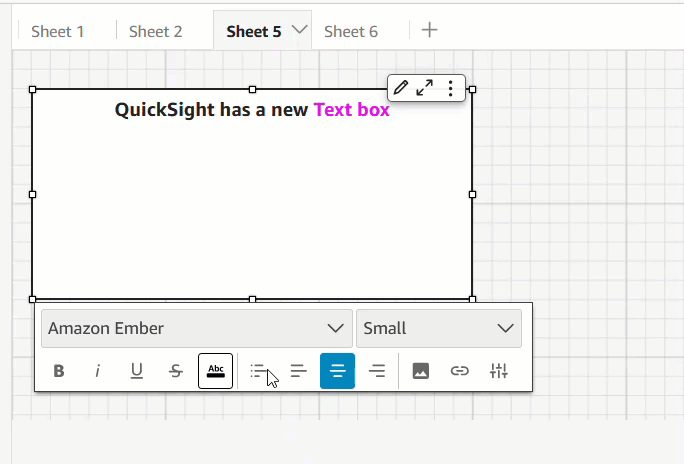AWS Business Intelligence Blog
Add text boxes to your Amazon QuickSight analysis
 |
All your trusted BI capabilities of Amazon QuickSight now come with powerful new AI features that integrate chat agents, deep research, and automation in one seamless experience with Amazon Quick Suite! Learn more » |
We are excited to announce the launch of text boxes in Amazon QuickSight. Now you can add text for common use cases, including but not limited to titles, subtitles, annotations, adding additional information for KPIs etc has been simplified than ever before with the new text box. You can reposition, resize, and make your text stand out with various rich text formatting options like font styling, text alignment, and text box styling. You can also add dynamic text values with the help of user-defined parameters and system-defined parameters like date and page number.
In this post, we explore the new text box feature and its benefits.
Solution overview
The new text box feature may feel like an overlap with narrative insight capabilities, which is focused on advance use cases where a text box is lightweight, focused on simplified textual content, and doesn’t need any data assignment. You can add text boxes without being restricted by the total visual limit because it’s not counted towards the sheet visual limit.

You can do the following with a text box in QuickSight:
- Add freehand text and display dynamic text values with the help of parameters
- Support reporting use cases with system-defined parameters like date and page count
- Perform rich text editing with font styling options, alignment options, and bulleting
- Add an image to your text box, such as displaying your company logo with the analysis title text
- Hyperlink your text to navigate to a different sheet or external URLs
- Style your text box with background color and border styling options
Add a text box to an analysis sheet
- To add a text box to your analysis, you can either choose Add on the drop-down menu or choose the text box icon from the visual selector. Note that unlike other visuals, you can’t convert a text box to another visual, or vice versa.

- You now have an empty text box on the sheet. To position the text box, select the box and drag it from the borders. To resize the text box, select and drag any of the outline handles.
- Now you can add text and format it by using the various formatting options, such as:
- Font styling, including font style, color, and size
- Typographical emphasis, such as bold, italics, underline, and strikethrough
- Alignment options and bulleting
- You can hyperlink text or add a static or dynamic URL by choosing the URL icon.

- Just like adding parameters to titles and subtitles, you can display parameter values in a text box as well. Choose from a list of parameters available in the analysis from the parameter drop-down menu.

- Along with text, you can add images as well inside the text box by clicking the image icon.

- Apart from text formatting you can also format background and border color.

When you’ve finished editing the text box, click on the blank space on the sheet.
Add a text box to a reporting sheet
Although the steps to add a text box to a reporting sheet remain the same as that of an analysis sheet, you have two new system parameter options while adding the text box to the header or footer of your reporting sheet:
- Date parameter – Add the print date and time to your report by choosing the date parameter (
AWS:printTime) and selecting from a list of date formats. If your organization uses a different date format, you can customize it by choosing the added date and selecting from the list of supported date formats.

- Page parameter – Display the current page number (
AWS:pageNumber), total number of pages (AWS:pageCount), or a combination of both by choosing the page parameter.

Summary
In this post, we looked at how the new text box feature in QuickSight provides a great way to add text and format it with rich text capabilities and provide parameter support, URLs, and images. The new text box is now generally available in all supported QuickSight Regions.
Give the text box a try and let us know about your experience in the comments section.
Join the Quicksight Community to ask, answer and learn with others and explore additional resources.
About the author
 Bhupinder Chadha is a senior product manager for Amazon QuickSight focused on visualization and front end experiences. He is passionate about BI, data visualization and low-code/no-code experiences. Prior to QuickSight he was the lead product manager for Inforiver, responsible for building a enterprise BI product from ground up. Bhupinder started his career in presales, followed by a small gig in consulting and then PM for xViz, an add on visualization product.
Bhupinder Chadha is a senior product manager for Amazon QuickSight focused on visualization and front end experiences. He is passionate about BI, data visualization and low-code/no-code experiences. Prior to QuickSight he was the lead product manager for Inforiver, responsible for building a enterprise BI product from ground up. Bhupinder started his career in presales, followed by a small gig in consulting and then PM for xViz, an add on visualization product.
